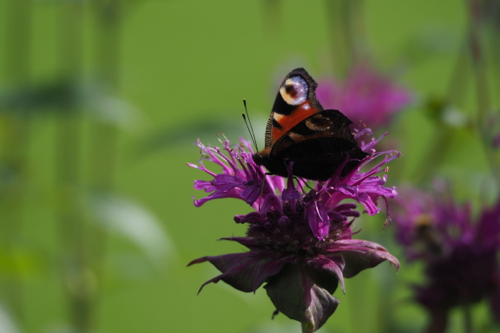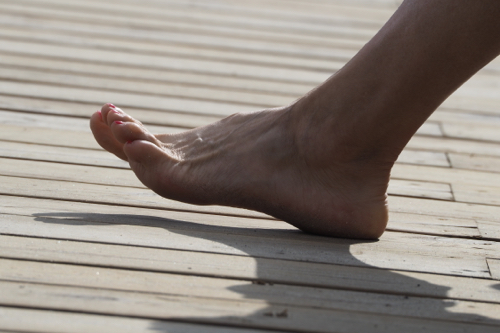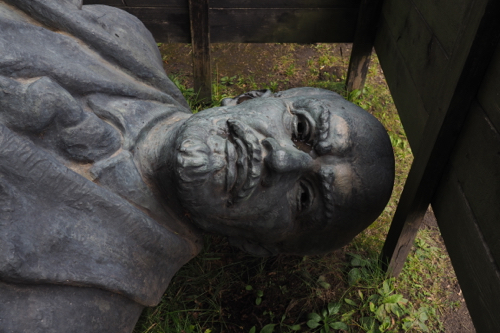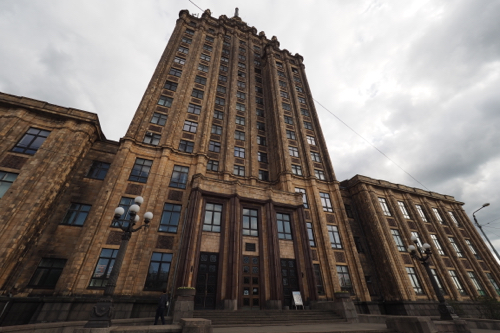August 20, 2017. Tallinn, Estonia.
We were back in Tallinn to start our trip along the Baltic Sea. Being our second time in the Estonian capital we decided to stay on the other side of the old town.
This time at a hotel, the Park Inn by Radisson, rather than an apartment.
Little did we know that there was a new office building being constructed, right next door.
And buildings sites work on Sundays in Tallinn.
After getting up earlier than we had planned, we walked to Kadriorg Park to ‘smell the roses’.
We discovered that nature also works on a Sunday as the bees and butterflies were hard at it.
Estonian flags were everywhere and we wondered why there were so many. They were on buildings, cars and some people were even carrying them.
Then we discovered that it was the Day of Restoration of Independence. This was the day in 1991 that the Estonian Supreme Soviet in association with the Estonian Congress proclaimed Estonian independence from the Soviet Union.
As a result of the festivities there were no museums open so we just had to walk around.
We did visit Kumu, the Art Museum of Estonia, but that was just for coffee.
The museum is housed in a very impressive, contemporary building on the edge of Kadriorg Park.
Like so many public buildings the architect, Pekka Vapaavuori, was the winner of a competition in 1994.
It was constructed between 2003 and 2006 and is built into the limestone slopes on the side of the park.
Again built on the edge of the centuries old Kadriorg Park is the Kadriorg Art Museum. In total contrast to the glass and steel of the Kumu Museum, this one is housed in the grand baroque palace, that was built for Peter the Great in 1718.
Designed by the Italian architect Niccolo Michetti it’s a fine example of Tsarist extravagance.
Unfortunately we didn’t get to go inside either as they were also shut.
August 21, 2017. Tallinn to Pärnu, Estonia.
It was meant to be 1.5 hours from Tallinn to Pärnu but due to roadworks and more rain it took a little longer.
The receptionists at the Hotel Carolina told Thea, when she enquired about the rain, that it had been a ‘light summer’
When we walked into Pärnu there was a removals’ van taking away the umbrellas from one cafe. Then we saw workers removing the summer veranda from another.
I’m afraid we have missed summer completely in this part of Europe.
Pärnu Beach is regarded as the best beach in Estonia, so we walked down to have a look.
There was no one bathing at this section of the beach but a number of people were wandering around on the sand.
I think they were looking for summer.
August 22, 2017. Pärnu, Estonia.
This was adventure day.
Thea had booked a day trip that involved a walk in a peat bog, lunch and a canoe ride on the Halliste River.
We didn’t know much more than that.
It turned out to be a great experience and a chance to “enjoy the nature” as the locals say.
The entire excursion was set in Soomaa National Park, with the walk on the Ingasi nature trail.
Soomaa means ’The Land of Mires’. Over time these mires developed into bogs.
The trail was a combination of boardwalks, soil trails and a bog walk that required special ‘bog shoes’ that were provided.
At the end there is an 8 metre high observation tower that allows you to overlook the bog and the forests beyond.
Lunch was provided and certainly part of the experience.
It was traditional Estonian fair, that consisted of potato porridge, homemade barley bread and desert (Kama) that was made from curd cheese.
After lunch it was time for part two of our nature adventure, canoeing on the Halliste River.
There was a lot of serious instructions on how to go about canoeing, especially the possibility of ending up in the river.
I decided that my camera and equipment would be better off remaining behind.
It was probably a wise decision as the bottom of our canoe did start to fill up with water. This was a combination of bad paddling, on my behalf, and rain that that started when we were about half way through the trip.
The Halliste River is one of four rivers that separates the mires within the national park.
The other rivers are the Navesti, Raudna and Lemmjögi.
The Soomaa National Park was created in 1993 and is 359 square kilometres in size. It is situated in what’s called Transitional Estonia and has been created to protect the raised bogs, grasslands, flood plains and rivers.
August 23, 2017. Pärnu, Estonia to Cēsis, Latvia.
An elevator.
It’s only when you don’t have one that you appreciate them.
I thought this as we descended the five levels to the ground floor as we were leaving the Hotel Carolina in Pärnu.
Most of our hotels or apartments are booked through bookings.com and we always have standard requests such as free off-street parking, WiFi and non-smoking.
On the Eastern European stage of our trip, most of our accommodation has been in old cities and therefore old buildings.
Carting our bags up has become a pain, literally, so we now include a lift as standard request.
It doesn’t always work out that we get one, but when we do it’s much appreciated.
Before leaving Pärnu for Cēsis we made good use of the hotel’s free parking and left the Captur there and wandered around the town.
Pärnu is the fourth largest city in Estonia and situated on the coast of Pärnu Bay. The Pärnu River flows through the city and into the Gulf of Riga.
Perona, which was very close by, was founded in 1251 but was destroyed and replaced by the current town in 1265.
On our walk we discovered Villa Ammende, which was built in 1904. This mansion house is a fine example of the Art Nouveau style. It is now a luxury hotel that serves the resort area of Pärnu.
Another architectural discovery was the Church of the Saint Martyr Catharina.
Built in the baroque style, 1765-1768, by the architect Peter Yegorov and named after Catherine the Great.
Our apartment in Cēsis was a bit of a walk from the centre of town. But it was raining, again, so we found a restaurant close to home.
2 Locals had good food and service at a reasonable price but they only take cash.
This we discovered at the end of the meal.
I am very uncomfortable with cash only places, as they are probably cheating the system in one way or another.
I complained that there was nothing on the menu to alert me to their policy and was told that there was a sign on the front door.
It was back to front and almost invisible.
In Finland, Estonia, Poland, Slovakia and the Czech Republic, credit cards are the norm and you always get a receipt, whether you ask for it or not.
I can only assume that fraud, corruption and tax avoidance are still prevalent in this part of the former Soviet Union.
August 24, 2017. Cēsis, Latvia.
It rained all night and was still coming down in the morning. It was also cool, with the temperature hovering around 11°C.
With our lantern in hand we took off to explore the Cēsis Castle complex.
The lantern was so we could climb to top of the Western Tower, without being in complete darkness.
It wasn’t really necessary but it was a nice Medieval touch.
Cēsis Castle was built in the 13th century and the ruins are regarded as some of the most impressive in the Baltic states. It was once the most important castle of the Livonian Order. The Livonia Order was formed in 1237 and were a autonomous branch of the Teutonic Order.
During the Soviet occupation (1940 – 1990) Latvia, like the rest of the USSR, erected statues of Vladimir Ilich Lenin. One such statue was unveiled in Cēlcis in 1959. This particular statue was created by one of Latvia’s most talented 20th century sculptors, Kärlis Jansons (1896 to 1986). As a result, in the 1990 break-up of the Soviet Union, the statue was not destroyed but just dismantled.
It now lies in a wooden crate in the castle grounds.
Since 1949 the Cēsis History Museum has been situated in the New Castle of the Cēsis Castle estate. The Museum covers the history of Cēsis and the Latvian people.
A very interesting exhibit was the wax reconstruction of a woman, aged in her mid 20s, who was found after the siege of 1577 by Ivan the Terrible.
After visiting the castle we went for a walk in the Gauja National Park and Sarkanãs Cliffs. The Gauja National Park is the largest national park in Latvia with an area of over 917 square kilometres.
Everyone was there for the water, which must have had some healing powers, and not the walk.
The options for dinner were limited. After finding the main hotel was full, with tour groups, we discovered a local Latvian restaurant.
A much better option.
We ordered our meals but they were served to another table. Then they tried to get us to accept what the other table had ordered. We refused and then had to wait so that they could prepare what we had ordered in the first place.
The meal was worth the wait.
August 25, 2017. Cēsis to Rīga, Latvia.
On the way to Rīga we visited Sigulda Castle. Built in 1207, this was yet another the castle of the Livonian Order.
The Sigulda Castle Complex was under renovation as was the entire town. Road works and reconstruction was everywhere.
In Rīga we were staying in the Bearsleys Downtown Apartments. Getting to our apartment was a complex task. It did have a lift but we also had to negotiate stairs, a walk, more stairs and a second lift before we reached our rooms.
It certainly wasn’t that bad, as just opposite our apartment was Bierhaus, a gastro brewery.
How unfortunate.
All the staff at Bierhaus were ‘hipsters’ who had a great command of English and a wonderful sense of humour.
The brewer is an American architect, turned brewmaster, Gordon Van Houten. After abandoning architecture, fifteen years ago, Gordon studied brewing in Germany then brewed beer in both the States and now in Latvia.
His wife is Latvian, hence the connection.
August 26, 2017. Rīga, Latvia.
After breakfast in the apartment, which was a rare pleasure, we went looking for a coffee.
Miit Coffee was recommended by Triposo and right opposite our apartment.
This area is fantastic.
Great beer and coffee, just over the road.
We were in Rīga for five nights so we will be visiting both places more than once.
The day was spent discovering the city of Rīga.
It was about a 25 minute walk from our apartment, which was in ‘Downtown’ to the Old City.
Rīga Old Town is a UNESCO World Heritage site and has a history going back to 1201.
It was set up by Albert of Bremen as a port city and a base to convert the local Livonians to Christianity, which he did by 1206.
Rīga has a diverse population, due to its rich history, which has been influenced by the many nationalities who have called it home over the centuries.
The Old Town is very compact and easy to get around.
Rīga is the capital of Latvia and has a population of over 700,000 inhabitants. One in three Latvians live in the city and its surrounds.
During the Soviet occupation Rīga was a popular destination with the Russian tourists and many Russians were living there as well. A lot of work was done to restore the Old City and make it more attractive.
In 1989 only 36.5% of the population in Rīga were Latvians.
Having eaten at a Brewpub one night, it seemed only fair that we go to a gastro wine bar, that was just around the corner, the next.
It was a Saturday night and they were shut.
It was a great area for beer and coffee but not for restaurants.
We did find an Armenian restaurant that was close by and ok.
The food was fine but the service a little gruff – all part of the great Socialist experiment that spread the Russian’s lack of humour from the Baltic States through Armenia, Georgia and Central Asia.
August 27, 2017. Rīga, Latvia.
We drove 25 kilometres west from Rīga to Jūrmala. This is a resort town with a population of about 57,000, making it the the fifth largest city in Latvia.
There is a toll of €2 to get into the town.
I think all the money goes into hanging baskets – they were everywhere.
Jūrmala has a 33 kilometre stretch of sandy beach which is long, flat and very, very shallow. You would have to almost walk to Sweden before the water got over your head.
When Latvia was part of the Soviet Union, Jūrmala was a popular holiday resort for the high ranking Soviet officials.
Leonid Brezhnev and Nikita Kruschchev graced their shores.
Not a pretty sight I am sure.
After an ice cream and a coffee on the beach we drove, west to the Kemeri National Park. There we had a choice of two walks – the floodplain forest or forest trail which are both on the Vēršupīte River.
They were only about 1.2 kilometres in total, so we decided to do both.
The Vēršupīte River is fed from sulphur springs, which is obvious to the nose and a boom for the many therapeutic health resorts in the area.
There were wheel chairs everywhere.
August 28, 2017. Rīga, Latvia.
Today we went in search of the Art Nouveau district, which wasn’t far from our apartment.
There are about 800, so called, Art Nouveau buildings within Rīga.
This architectural style comes from the early years of the 20th century. And unlike other, older styles, many of these buildings were designed by Latvian architects.
Art Nouveau in Europe was popular between 1890 and 1910 and inspired by natural forms, particularly plants and flowers.
In Latvia it’s known as Jugendstil.
Art Deco replaced Art Nouveau in 1910 and I think that there are many buildings that have been attributed to the wrong era, as I didn’t see that many authentic Art Nouveau buildings on our city walks.
Because of the decorative nature of Art Nouveau, there is a lot of surface sculpture and floral moulding on the building facades.
If not properly maintained, this has a habit of coming lose, so a number of buildings were covered in protective netting.
Rīga Central Market is the largest in Europe and part of the city’s UNESCO World Heritage Listing.
It was constructed from 1924 to 1930 using old German Zeppelin hangars, as a basis for the design. The architectural style incorporates both Neoclassicism and Art Deco.
It measures 72,300 square metres with over 3,000 traders.
Traders have been operating on the banks of the Duagava River since 1571, so the area is no stranger to commerce.
August 29, 2017. Rīga, Latvia.
About 300 metres from our apartment was Gastranome, a gourmet food store, delicatessen, café, patisserie and butcher.
Yes, on one side of this huge store was a purveyor of fine meat.
In large refrigerated cabinets were, what looked like, quality cuts of dry-aged beef.
On the other side was everything else.
And upstairs was an upmarket seafood restaurant.
While we were in an apartment we decided to eat in one night and availed ourselves of the wide selection that Gastranome had to offer.
The selection was huge and the quality top class.
As our apartment didn’t really have any condiments or ingredients to look after ourselves and cook, we decided to go for the pre-prepared take-away options.
Our last day in Rīga was spent just wandering around and revisiting some of our favourite sites. Especially those that had been difficult to capture, when the weather was foul and the light poor.
I was particularly taken by the Central Market and felt that I really hadn’t done justice to the place.
That, and the Dome Cathedral, definitely needed re-visiting.
We also discovered a monument to George Armitstead, who was the Mayor of Rīga from 1901 to 1912.
Born in 1847 to a British merchant family he became the fourth Mayor of Rīga. George was responsible for the cites rapid transformation from a regional town to a major city.
He was involved in the development of many of Rīga’s current building,s including 13 schools, 3 hospitals, the National Museum and the Zoo.
Many of these developments would have been during the Art Nouveau style, as his time in office was during that short period in architectural history.
At one point he was asked to become Mayor of St Petersburg by Emperor II of Russia – he refused.
On our final night we returned to the Brewpub across the road and again we weren’t disappointed.
The beer, was still, good and the food innovative, fresh and well presented.
It wasn’t nearly as busy as the first night we visited, so we got chatting to one of the owners.
He was one of four that have set out to create a real Gastro Brewery in Rīga.
Three of the owners are Latvian while, as I have mentioned, the brewer is an American guy, married to a Latvian woman, who needed to return home.
Originally an architect he decided to turn his hand to brewing. Latvia is better off for his change in occupation, as his beer is the best we have had in the Baltic States.
The current name of their restaurant is Bierhaus, which is very German. Which isn’t surprising as this is the origin of the original restaurant.
They are now trying to tun it into a contemporary Brewpub, under the name of ‘Alķīmiķis’ but are realising that time, and money, are involved.
I think they will succeed, as their ideas are sound and their product is exceptional.
Most of the local breweries are very traditional and a quality craft brewer will give the market a shake up.
I just hope that they can turn beer into gold.
Miit Coffee, which were next door, are also innovators. They have developed a confectionary, that looks like chocolate, but is made from coffee. Each segment in a bar has the equivalent hit of a double shot espresso.
August 30, 2017. Rīga to Kuldīga, Latvia.
It was about two hours to Kuldīga, west of Rīga. We extended the drive by going to the coast, which is further north, and stopped in Ventspils.
This is a Blue Flag Beach. Blue Flag is certification by the Foundation for Environmental Education (FEE). It is only designated to those beaches, marinas or tourist boating that meets its very high standards.
The temperature had finally decided to rise above 17°C and managed to get to 25°C by the time we reached Kuldīga.
In the afternoon we wandered around the town. One of the features is the Kuldīga Bridge which was built of brick in 1874 and runs across the Venta River. The Alekšupīte River runs through the centre of town while the Venta Rapids are the widest waterfall in Europe, measuring 164 metres.
Kuldīga is an ancient town, with interesting architecture and a history dating back to 1242.
Being much warmer that night we ate at the hotel – outside.




















